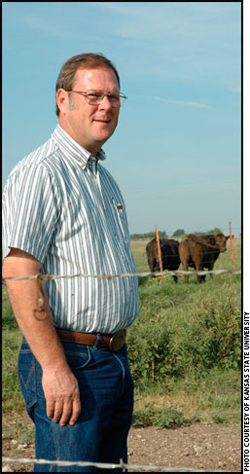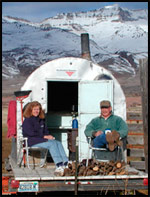MANAGEMENT...

Lyle Lomas, Kansas State University
Stockers Set Up Beef Quality
The stocker segment is a critical link that can influence performance and carcass characteristics later in life.
Genetics were selected years ago; calving and weaning are complete, so the next place that really matters in the beef production chain is the feedlot. Right?
Not necessarily. A sandwich relies on what's between the bread slices; a great book must be compelling from cover to cover; and, likewise, the cattle industry often counts on the stocker phase to ensure cattle quality while moving them from ranch to feedlot.
"A growing body of research shows that the stocker segment is a critical link that can influence performance and carcass characteristics later on," says Larry Corah, vice president for supply development at Certified Angus Beef LLC (CAB). "Health continues to be an important variable to control, but two recent studies dial down into some specific nutritional management that could make a difference." Read more.

Ron Torell with his wife, Jackie
Cow Camp Chatter
Enjoy the process.
I recently received some very sound advice from a trusted and loyal friend that is worth passing on: "Slow down and enjoy the process."
Most agriculture producers are just like me. On any given day they have too many irons in the fire and too much on their minds. Consequently, we all try to do too much in a day with too little help and too few resources. The slim profit margin agriculture offers is simply too small to afford the labor force and infrastructure we once enjoyed, so we simply do without. We rely heavily on our family, neighbors and friends to fill this labor void. We shoulder the bulk of the added burden and are often unable to enjoy the process and the reason we are in agriculture production to begin with. We hurry through one job so we can move on to the next. We become crisis managers rather than ranch managers.
In this edition of "Cow Camp Chatter," let's discuss the subject of slowing down and enjoying the process, and how, by doing so, we may become more efficient ranch managers and more enjoyable people to be around. Read more.
 Choosing a Summer Annual Forage
Choosing a Summer Annual Forage
Livestock producers in diverse production environments have long used summer annual forages to produce hay and for supplemental pasture. However, some producers may not be aware of the variety of summer annuals available and how different species may suit different purposes.
"Generally speaking, the choice of summer annual planted depends on the intended use of the forage — whether it will be grazed or harvested as hay or silage," says Bruce Anderson, University of Nebraska forage specialist. "Depending on the purpose, there may be two, three or more choices that fit best." Read more.
Fewer Weeds = More Cows
A weed calculator developed by an ARS scientist tells ranchers the number of additional cows they could raise if they eliminated one or two widespread exotic invasive weeds.
Rangeland ecologist Matt Rinella at the ARS Fort Keogh Livestock and Range Research Laboratory in Miles City, Mont., created a computer model that predicts weed effects on forage production. In addition to developing the calculator so that ranchers could calculate what weeds are costing them on any given site, Rinella used the data to estimate what weeds are costing ranchers in a 17-state region. For example, he calculated that if leafy spurge were eliminated, ranchers in that region could graze up to 200,000 or more cows a year and save tens of millions of dollars. Read more.
Sterilize, Don't Kill Weeds
ARS researchers offer a new way to use herbicides.
Using herbicides to sterilize rather than to kill weedy grasses might be a more economical and environmentally sound weed control strategy, according to a study by Agricultural Research Service (ARS) scientists and a cooperator. Rangeland ecologist Matt Rinella at the ARS Fort Keogh Livestock and Range Research Laboratory in Miles City, Mont., conducted the study with colleagues at Miles City and Robert Masters with Dow AgroSciences LLC in Indianapolis, Ind.
Exotic annual grasses such as Japanese brome, cheatgrass and medusahead are harming millions of acres of grassland in the western United States. Currently, the herbicides used to control these invasive grasses also sometimes damage desirable perennial grasses. In contrast, when used properly, growth regulators typically do not greatly harm desirable perennial grasses. Growth regulator herbicides are used to control broadleaf weeds in wheat and other crop grasses, as well as on rangelands. Rinella and his colleagues knew that when dicamba and other growth regulator herbicides were applied to cereal crops late in their growth stage, just before seed formation, the plants produced far fewer seeds.
The scientists decided to see if these herbicides had the same harmful late-stage application effects on the invasive weed Japanese brome. In greenhouse experiments, they tested dicamba (Banvel/Clarity), 2,4-D, and picloram (Tordon) at typically used rates. They found that picloram reduced seed production nearly 100% when applied at the late growth stage of the weed. Dicamba was slightly less effective, but still nearly eliminated all seed production, while 2,4-D was much less effective.
Since annual grass seeds only survive in soil a year or two, it should only take one to three years of herbicide treatment at the right growth stage to greatly reduce the soil seed bank of annual weedy grasses without harming perennial grasses.
Rinella has recently finished field tests that support the greenhouse experiment results. He also tested the herbicide aminopyralid (Milestone) and found it was as effective as picloram. Next he will test much lower doses of the herbicides in an attempt to lower costs and reduce non-target damage to broadleaf plants.
Managing Fly Tag Resistance
It's easy to see why so many cattle producers use ear tags impregnated with insecticide for controlling flies that torment cattle, spread disease and hamper performance. It's convenient, particularly for pasture cattle. The animals don't have to be gathered repeatedly for applications of topical insecticides. Once tags are applied, cattle can receive 12-15 weeks of control for horn flies and face flies, the most troublesome fly pests.
There are times, however, when results fall short of expectations. Fly populations can develop resistance to insecticides used in fly tags. Generally, says Oklahoma State University Extension Entomologist Justin Talley, insecticide resistance can be managed through more careful selection and use of fly tags, or other fly control products.
"Continuous use of the same insecticide or class of insecticide will eventually result in fly populations that cannot be controlled. Resistance management just requires a little planning and attention to detail," Talley says.
To optimize results from fly tags, Talley advises producers to develop a plan for rotating the type of tag used. Some tags contain a pyrethroid insecticide, while others contain an organophosphate. Additionally, one manufacturer markets tags impregnated with an organochlorine chemical belonging to a third class of insecticide. Don't just change brands of fly tags, however, as competing brands may use the same insecticide. Make sure to rotate to a different class of chemical.
"I advise against using pyrethroid tags more than once every three years, and don't use organophosphate tags for more than two consecutive years," Talley offers. "The third class of chemical (organochlorine) can also be incorporated into the rotation strategy."
Talley also warns against applying ear tags too early in the season. Particularly when targeting horn flies, he recommends application when populations approach levels of 200 flies per animal, on average. Research suggests lower population levels typically aren't of economic consequence. Tags applied too early may not last through late summer when fly populations remain high. And exposing late-season flies to low doses of insecticide contributes to resistance problems. For the same reason, fly tags should always be removed in the fall.
"Don't apply fly tags to cattle more than once per season," Talley adds. "If additional control is needed late in the season, use a different control method such as sprays, back rubbers or dust bags. It's also best to change class of insecticide when changing control method."

Kris Ringwall
Beef Talk
An ounce of prevention is worth a pound of cure.
The Benjamin Franklin axiom that "an ounce of prevention is worth a pound of cure" is as true today as it was when Franklin made the quote. Although many use the quote when referring to health, Franklin actually was addressing fire safety.
We should all relate to Franklin. Regardless of the endeavor, our tendency is to be a bit sloppy at times. For the unfortunate few for whom the hands of chance all line up, disaster is the outcome. Read more.
Environmental Regulations
EZRegs offers easy access to environmental regulation information affecting farmers.
The EZRegs website developed by University of Illinois (U of I) Extension specialists has been updated to include new information on key agricultural environmental regulations. Located at www.ezregs.illinois.edu, the website identifies environmental regulations that pertain to a variety of ag-related areas, including livestock production, food crop production, ornamental horticulture production, landscape maintenance, and small-scale animal facilities.
"Finding information on state and federal environmental regulations can often be difficult and confusing," said Ted Funk, U of I Extension agricultural engineer. "This website allows users to access frequently asked questions related to their interest area to find out what regulations may impact them and how. They can read the actual regulation and in many cases an interpretation of the regulation. Read more.
New Products
Industry affiliates provide a wide array of products and services to assist you on the farm and ranch. Here's an assortment of new products to hit the market recently.
• Company adds vaccines, sizes
• Multispecies colostrum replacement
• Federal registration approval for herbicide
• Convert PAR 36 incandescent lamps to LED
• Turbocharged utility tractor
• First-ever consumables catalog
• Tripod-mounted, explosion-proof metal halide light
• Roll-up covers now available for 2011 Ford Super Duty short-bed pickups
Rotational Grazing May Reduce Starling Population
MU wildlife experts track starling breeding success near different types of pastures.
European starlings are the bane of U.S. cattle producers and dairy operators. These fast-breeding birds often flock near farmsteads and feedlots, eating and contaminating livestock feed. They also damage property and equipment; create health and safety hazards; and put stress on livestock, which lowers milk production and raises veterinary costs. Read more.
Angus Advisor
Click here for May herd management tips from cattle experts across the nation. Advice separated by region.
[Click here to go to the top of the page.]




